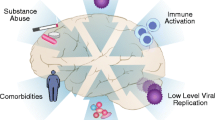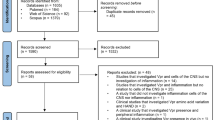Abstract
Despite major advances in HIV-1 treatment, the prevalence of HIV-associated neurocognitive disorders (HAND) remains a problem, particularly as individuals on suppressive treatment continue to live longer. To facilitate discussion on emerging and future directions in HAND research, a meeting was held in Durban, South Africa in March 2015 as part of the Society of Neuroscientists of Africa (SONA) conference. The objective of the meeting was to assess the impact of HIV subtype diversity on HAND and immunological dysfunction. The meeting brought together international leaders in the area of neurological complications of HIV-1 infection with special focus on the African population. Research presentations indicated that HAND was highly prevalent and that inflammatory cytokines and immune-activation played important roles in progression of neurocognitive impairment. Furthermore, children on antiretroviral therapy were also at risk for developing neurocognitive impairment. With respect to the effect of HIV-1 subtype diversity, analyses of HIV-1 clade C infection among South Africans revealed that clade C infection induced cognitive impairment that was independent of the substitution in HIV-1 Trans-Activator of Transcription (Tat; C31S). At the cellular level, a Zambian study showed that clade C infection resulted in reduced brain cell death compared with clade B infection suggesting clade specific variations in mediating brain cell injury. Furthermore, ex vivo Tat protein from clade CRF02_AG, prevalent in West/ Central Africa, exhibited reduced disruption of brain endothelium compared with clade B Tat protein. Discussions shed light on future research directions aimed at understanding biomarkers and disease mechanisms critical for HAND.
Similar content being viewed by others
References
Antinori A, Arendt G, Becker JT, Brew BJ, Byrd DA, Cherner M, Clifford DB, Cinque P, Epstein LG, Goodkin K, Gisslen M, Grant I, Heaton RK, Joseph J, Marder K, Marra CM, McArthur JC, Nunn M, Price RW, Pulliam L, Robertson KR, Sacktor N, Valcour V, Wojna VE (2007) Updated research nosology for HIV-associated neurocognitive disorders. Neurology 69:1789–1799
Bhargavan B, Woollard SM, Kanmogne GD (2016) Toll-like receptor-3 mediates HIV-1 transactivation via NFkappaB and JNK pathways and histone acetylation, but prolonged activation suppresses Tat and HIV-1 replication. Cell Signal 28:7–22
Gray F, Chretien F, Vallat-Decouvelaere AV, Scaravilli F (2003) The changing pattern of HIV neuropathology in the HAART era. J Neuropathol Exp Neurol 62:429–440
Heaton RK, Franklin DR, Ellis RJ, McCutchan JA, Letendre SL, Leblanc S, Corkran SH, Duarte NA, Clifford DB, Woods SP, Collier AC, Marra CM, Morgello S, Mindt MR, Taylor MJ, Marcotte TD, Atkinson JH, Wolfson T, Gelman BB, McArthur JC, Simpson DM, Abramson I, Gamst A, Fennema-Notestine C, Jernigan TL, Wong J, Grant I (2011) HIV-associated neurocognitive disorders before and during the era of combination antiretroviral therapy: differences in rates, nature, and predictors. J Neurovirol 17:3–16
Hoare J, Fouche JP, Spottiswoode B, Donald K, Philipps N, Bezuidenhout H, Mulligan C, Webster V, Oduro C, Schrieff L, Paul R, Zar H, Thomas K, Stein D (2012) A diffusion tensor imaging and neurocognitive study of HIV-positive children who are HAART-naive "slow progressors". J Neurovirol 18:205–212
Hoare J, Fouche JP, Phillips N, Joska JA, Donald KA, Thomas K, Stein DJ (2015) Clinical associations of white matter damage in cART-treated HIV-positive children in South Africa. J Neurovirol 21:120–128
Joseph J, Achim CL, Boivin MJ, Brew BJ, Clifford DB, Colosi DA, Ellis RJ, Heaton RK, Gallo-Diop A, Grant I, Kanmogne GD, Kumar M, Letendre S, Marcotte TD, Nath A, Pardo CA, Paul RH, Pulliam L, Robertson K, Royal W 3rd, Sacktor N, Sithinamsuwan P, Smith DM, Valcour V, Wigdahl B, Wood C (2013) Global NeuroAIDS roundtable. J Neurovirol 19:1–9
Maschke M, Kastrup O, Esser S, Ross B, Hengge U, Hufnagel A (2000) Incidence and prevalence of neurological disorders associated with HIV since the introduction of highly active antiretroviral therapy (HAART). J Neurol Neurosurg Psychiatry 69:376–380
McArthur JC, Haughey N, Gartner S, Conant K, Pardo C, Nath A, Sacktor N (2003) Human immunodeficiency virus-associated dementia: an evolving disease. J Neurovirol 9:205–221
Paul RH, Joska JA, Woods C, Seedat S, Engelbrecht S, Hoare J, Heaps J, Valcour V, Ances B, Baker LM, Salminen LE, Stein DJ (2014) Impact of the HIV Tat C30C31S dicysteine substitution on neuropsychological function in patients with clade C disease. J Neurovirol 20:627–635
Ranga U, Shankarappa R, Siddappa NB, Ramakrishna L, Nagendran R, Mahalingam M, Mahadevan A, Jayasuryan N, Satishchandra P, Shankar SK, Prasad VR (2004) Tat protein of human immunodeficiency virus type 1 subtype C strains is a defective chemokine. J Virol 78:2586–2590
Rao VR, Neogi U, Talboom JS, Padilla L, Rahman M, Fritz-French C, Gonzalez-Ramirez S, Verma A, Wood C, Ruprecht RM, Ranga U, Azim T, Joska J, Eugenin E, Shet A, Bimonte-Nelson H, Tyor WR, Prasad VR (2013) Clade C HIV-1 isolates circulating in Southern Africa exhibit a greater frequency of dicysteine motif-containing Tat variants than those in Southeast Asia and cause increased neurovirulence. Retrovirology 10:61
Robertson K, Liner J, Hakim J, Sankale JL, Grant I, Letendre S, Clifford D, Diop AG, Jaye A, Kanmogne G, Njamnshi A, Langford TD, Weyessa TG, Wood C, Banda M, Hosseinipour M, Sacktor N, Nakasuja N, Bangirana P, Paul R, Joska J, Wong J, Boivin M, Holding P, Kammerer B, Van Rie A, Ive P, Nath A, Lawler K, Adebamowo C, Royal W 3rd, Joseph J (2010) NeuroAIDS in Africa. J Neurovirol 16:189–202
Sacktor N, McDermott MP, Marder K, Schifitto G, Selnes OA, McArthur JC, Stern Y, Albert S, Palumbo D, Kieburtz K, De Marcaida JA, Cohen B, Epstein L (2002) HIV-associated cognitive impairment before and after the advent of combination therapy. J Neurovirol 8:136–142
Sacktor N, Nakasujja N, Robertson K, Clifford DB (2007) HIV-associated cognitive impairment in sub-Saharan Africa—the potential effect of clade diversity. Nat Clin Pract Neurol 3:436–443
Wainberg MA (2004) HIV-1 subtype distribution and the problem of drug resistance. Aids 18(Suppl 3):S63–S68
Woollard SM, Bhargavan B, Yu F, Kanmogne GD (2014) Differential effects of Tat proteins derived from HIV-1 subtypes B and recombinant CRF02_AG on human brain microvascular endothelial cells: implications for blood–brain barrier dysfunction. J Cereb Blood Flow Metab 34:1047–1059
Acknowledgments
We thank the following for their support of the workshop held in Durban in March 2015:
National Institute of Mental Health (NIMH)
Society of Neuroscientists of Africa (SONA)
We thank all patients who participated in these studies.
Author information
Authors and Affiliations
Corresponding authors
Ethics declarations
Conflict of Interest
This work was written as part of Dr. Jeymohan Joseph’s official duties as a government employee. The views expressed in this article do not necessarily represent views of NIMH, NIH, HHS, or the United States Government.
Funding
The authors acknowledge funding from National Institutes of Health: MH094160 (to GDK); DA036157 (to SB).
Rights and permissions
About this article
Cite this article
Buch, S., Chivero, E.T., Hoare, J. et al. Proceedings from the NIMH symposium on “NeuroAIDS in Africa: neurological and neuropsychiatric complications of HIV”. J. Neurovirol. 22, 699–702 (2016). https://doi.org/10.1007/s13365-016-0467-y
Received:
Revised:
Accepted:
Published:
Issue Date:
DOI: https://doi.org/10.1007/s13365-016-0467-y




